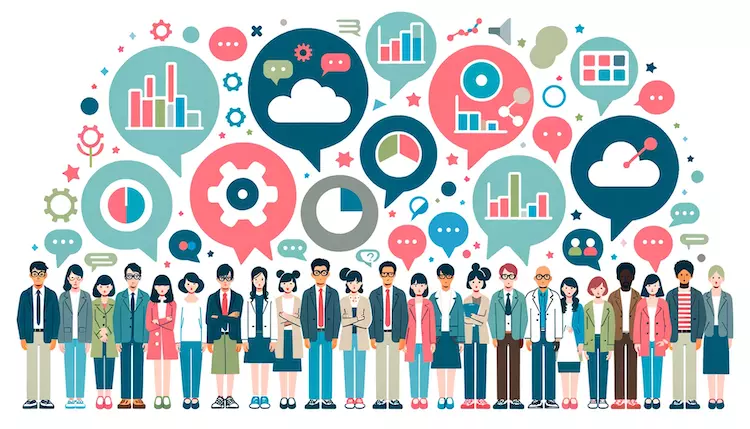Why Defining Your Target Audience Matters More Than Ever
The heart of every successful marketing campaign lies in understanding one’s target audience. Dive deep into this ocean of knowledge, and you’ll discover the treasure called the target audience profile. Why is it worth reading about? Simply put, without this map, you’re sailing blind in the vast sea of marketing.
Key Takeaways
- Understanding is Everything: A target audience profile is a comprehensive sketch of your ideal customer, delving into their dreams, desires, and dilemmas.
- Diversity in Audience: Marketing doesn’t have a one-size-fits-all approach. Segmenting your audience lets you tailor messages for maximum resonance.
- Persona Crafting: Creating a persona, a fictional representation of your audience, helps in humanising your data and refining your marketing message.
- Demographics Matter: Age, gender, socio-economic status, and other tangible information about your audience form the bedrock of any marketing strategy.
- Crafting an Audience Profile: Use tools, surveys, market research, and feedback loops to create a rich and dynamic audience profile.
- The Power of Segmentation: Segmenting your audience into specific groups allows for targeted marketing, increased engagement, and optimised budgets.
- Message Crafting: The essence of any marketing campaign is its message. Craft messages that resonate with the specific segments of your audience.
- Conversion is King: Turn audience interest into action. Personalise experiences, ease navigation, and have clear CTAs to boost conversions.
- Harnessing Digital Tools: Utilise tools like Google Analytics, SurveyMonkey, and SEMrush to enhance audience profiling efforts.
- Audience vs Target Market: The target audience is who you’re directly speaking to, while the target market is the broader group you aim to sell to.
- Engagement Strategies: Use interactive content, loyalty programs, and feedback channels to connect and engage with your audience meaningfully.
- The Future Beckons: With AI, machine learning, and predictive analytics, the future of audience profiling is exciting and filled with endless possibilities.
- Ethical Considerations: As we gather more data, ensuring privacy and data protection becomes paramount.
- Web Design’s Role: A brand’s digital space, crafted meticulously, can significantly enhance the connection with the target audience.
1. What Is a Target Audience Profile, and Why Is It a Game-Changer?
A target audience profile is a comprehensive and detailed portrait of your ideal customer. Picture it as a character sketch; it doesn’t just describe the obvious, like age and location, but delves deeper into their dreams, desires, and dilemmas.
Why does this matter? Because when your message resonates with the beating heart of your audience, it doesn’t just get heard; it gets embraced. Every marketer worth their salt knows the importance of sending the right message to the right audience.
But here’s the game-changer: with a well-defined target audience profile, your marketing campaign isn’t just another voice in the cacophony. It becomes a symphony that speaks directly to the soul of your potential customer.
2. Different Types of Target Audiences: Who Are You Speaking To?
Table 1: Different Types of Target Audiences
| Audience Type | Description |
|---|---|
| General Audience | Broad group with diverse interests. |
| Segmented Audience | A sub-group with specific shared characteristics. |
| Niche Audience | Highly specialised group, often with a unique interest. |
| Local Audience | Geographically defined, e.g., a town or region. |
| Global Audience | Spread across countries, transcending borders. |
In marketing, there isn’t a one-size-fits-all. The beauty of the modern age is the diverse array of people we can connect with. Your product or service might appeal to a local audience in Manchester, or it could be the rage across European countries. By segmenting your audience, you’re not putting them in boxes; you’re tailoring your message to resonate with their unique frequencies.
3. The Art of Persona: Painting a Vivid Picture
A persona is a fictional representation of your target audience. Think of it as creating a character for a novel. This character embodies the traits, habits, and behaviours of your audience. But why create a persona?
- It humanises your audience: Instead of seeing them as numbers on an analytics report, you see them as real people with real problems looking for real solutions.
- It refines your message: When you speak to someone you know, you tailor your words, tone, and tempo. A persona lets you do that for your target audience.
- It drives engagement: Imagine writing a love letter without knowing who it’s for. It would be generic, bland, and uninspiring. With a persona, your marketing message becomes that heartfelt note, evoking emotions and driving action.
4. Demographics: Beyond Just Age and Gender
Demographics are the tangible bits of information about your audience. It’s not just about how old they are or where they’re from. It dives deeper.
List of Demographic Factors:
- Age
- Gender
- Socio-economic status
- Education level
- Occupation
- Location
- Marital status
- Number of children
While these might seem basic, they’re the building blocks. Knowing that your target audience consists of single mothers in their 30s, juggling work and kids, can shape how you present your product or service. It’s the difference between saying, “Our product saves time” and “Get quality moments with your kids, while our product handles the rest.”
5. Crafting the Perfect Audience Profile: Where to Begin?
Ever wondered how seasoned marketers seem to effortlessly connect with their audience? The secret sauce is a well-crafted audience profile. But where does one start? The journey begins with an understanding and a sprinkle of creativity.
Steps to Create an Audience Profile:
- Gather Existing Data: Dive into tools like Google Analytics to understand who currently interacts with your brand. What age group do they fall into? Where are they located?
- Conduct Surveys: Send out surveys to your existing customer base. Ask open-ended questions to understand their pain points, desires, and motivations.
- Market Research: Look beyond your brand. What does the broader market landscape look like? Who are the major players targeting?
- Feedback Loops: Encourage feedback on your product or service. This is gold! It’s direct insight into what your customers love or loathe.
- Consolidate and Analyse: With all this information, craft a detailed audience profile. Remember, this isn’t static. As consumer behaviour evolves, so should your profile.
6. Why is Audience Profiling So Important?
It’s simple: Knowledge is power. When you deeply understand your audience, you hold the power to create marketing campaigns that not just inform, but inspire. Here’s why audience profiling is non-negotiable:
- Personalised Campaigns: With a clear audience profile, you can tailor your campaigns to speak directly to your audience’s heart. It’s the difference between generic marketing and a personalised message.
- Better ROI: Every penny spent targeting the right audience yields better results. Think about it – pitching vegan products to a vegan audience versus a random group. The former is bound to give better returns.
- Long-term Engagement: When your audience feels understood, they engage more. This isn’t just about immediate sales. It’s about building long-term relationships.
7. Tips for Successful Audience Profiling
Crafting the perfect audience profile isn’t just about data. It’s an art. Here are some tips to master this art:
- Diversify Your Data Sources: Don’t rely on just one tool or method. The richer your data sources, the more comprehensive your profile.
- Stay Updated: Consumer behaviour isn’t static. Regularly revisit and update your audience profile.
- Segmentation: Remember, one size doesn’t fit all. Segment your audience and create mini-profiles if necessary.
8. Determining Your Target Audience: Beyond the Obvious
Determining your target audience goes beyond the surface. It’s not just about who they are, but also when and how to reach them. Imagine selling ice creams in winter. It’s not about the product but the timing.
Table 2: Reaching Your Audience at the Right Time
| Platform | Best Time to Engage |
|---|---|
| Social Media Platforms | Late afternoon to early evening. |
| Email Campaigns | Mid-week mornings. |
| Webinars | Weekday afternoons. |
| Product Launches | Weekends or public holidays. |
9. The Power of Audience Segmentation
Imagine trying to strike a conversation in a room full of diverse personalities. A one-size-fits-all approach won’t work. That’s where audience segmentation comes into play in marketing. By breaking down your broader audience into smaller, more specific groups, you can tailor your message for maximum impact.
Benefits of Audience Segmentation:
- Targeted Marketing: Each segment gets a message tailored to their specific needs and preferences.
- Increased Engagement: Personalised messages resonate more, leading to higher engagement rates.
- Optimised Budgets: Instead of a broad-brush approach, you can allocate funds to campaigns that target specific, more lucrative segments.
Key Ways to Segment Your Audience:
- Demographic Segmentation: Based on age, gender, income, education, etc.
- Geographical Segmentation: Targeting based on location – city, region, country.
- Behavioural Segmentation: Based on user behaviour like purchase history, website visits.
- Psychographic Segmentation: Delving into lifestyle, values, and interests.
10. Message Crafting: Speaking Their Language
The crux of any marketing effort is the message. Once you’ve segmented your audience, it’s essential to craft messages that echo their sentiments. Remember, it’s not about what you want to say, but what they want to hear.
Tips for Crafting the Perfect Message:
- Empathy is Key: Put yourself in their shoes. Understand their pain points and aspirations.
- Be Clear and Concise: Remember, attention spans are dwindling. Get to the point and make it compelling.
- Call to Action: End with a clear CTA. What do you want them to do next? Make it obvious.
11. The Art of Conversion: Turning Interest into Action
Every marketer’s dream is to see interest translated into action – be it a sale, a sign-up, or a subscription. But this conversion doesn’t happen magically. It’s a science, driven by a deep understanding of your audience profile.
Steps to Boost Conversion:
- Personalised Experience: If they’ve shown interest in a particular product, show them similar items.
- Ease of Navigation: Whether it’s a website or a store, make their journey smooth and intuitive.
- Engage and Educate: Use tools like blogs, webinars, and videos to educate them about your product or service.
- Clear CTA: Make it easy for them to take the desired action. If it’s an online store, a visible ‘Buy Now’ button is crucial.
12. Profiling in Action: Real-world Success Stories
Let’s delve into some real-world examples where companies aced their audience profiling game:
- Netflix: They don’t just suggest movies; they suggest what you’d love to watch next. How? By understanding viewer preferences and segmenting their audience based on viewing patterns.
- Nike: With their “Just Do It” campaign, they resonated with not just athletes but everyone with a dream and a hurdle. They profiled their audience as dreamers, not just doers.
13. Harnessing Technology: Tools to Perfect Your Audience Profile
In this digital age, technology is the magic wand that can transform your audience profiling efforts from good to exceptional. Harnessing the right tools can give you insights deeper than ever before.
Must-have Tools for Audience Profiling:
- Google Analytics: Dive deep into who’s visiting your site, their demographics, interests, and more.
- SurveyMonkey: Create detailed surveys to gather insights directly from your audience.
- SEMrush: Understand market trends, what your competitors are doing, and where you stand.
14. The Blurring Lines: Audience vs Target Market
A common confusion many marketers face is the difference between the target audience and the target market. While they might seem interchangeable, they serve distinct roles.
- Target Audience: This is about who you’re speaking to directly. It’s the group of people most likely to respond to your message.
- Target Market: This is the broader group you aim to sell your product or service to. It includes everyone who could potentially become a customer.
Think of it this way: If you’re selling a youth-centric skincare product, your target audience might be teenagers, but your target market includes their parents too, who might purchase it for them.
15. Tips to Connect and Engage with Your Audience
Knowing your audience is half the battle won. The next step? Engaging with them in meaningful ways.
Engagement Strategies:
- Interactive Content: Quizzes, polls, and interactive videos can be a fun way for your audience to engage with your brand.
- Loyalty Programs: Reward your regular customers. It’s a way to say ‘thank you’ and ensures they keep coming back.
- Feedback Channels: Always have a channel open for feedback. It shows you care and are always looking to improve.
16. The Future of Audience Profiling: What Lies Ahead?
The world of marketing is ever-evolving. With the advent of AI and machine learning, audience profiling is set to reach new heights.
- Predictive Analytics: Imagine knowing what your customer wants before they do. With AI-driven analytics, this is soon becoming a reality.
- Hyper-personalisation: Gone are the days of broad categorisations. The future lies in hyper-personalised content, tailor-made for each individual.
- Ethical Considerations: As we gather more data, ethical considerations will take centre stage. It’s crucial to ensure privacy and data protection.
Conclusion: The Heartbeat of Modern Marketing
In the dynamic world of marketing, the compass that consistently points towards success is a deep, intimate understanding of one’s audience. Crafting a detailed target audience profile isn’t just a task; it’s an art. It’s the bridge that connects brands to consumers, aspirations to solutions, and products to those who truly need them. As we’ve journeyed through the nuances of audience profiling, one truth stands clear: when businesses listen, truly listen, to their audience, they don’t just sell – they build lasting relationships, foster trust, and carve a niche in the hearts of their consumers.
Call to Action: Interested in taking your business to the next level? Let our top-notch web design services craft a digital space that resonates with your target audience. Dive into a world where design meets functionality and where your brand’s voice gets the spotlight it deserves. Explore our web design services now. Because in the digital age, the first impression is often the only impression. Make it count!
Other articles to help you plan your website…
FAQs
1. Why is audience profiling important?
Audience profiling is pivotal because it allows businesses to understand and connect with their target audience on a deeper level. This understanding is essential for crafting marketing messages that resonate, leading to enhanced customer engagement. Moreover, audience profiling provides valuable insights into audience demographics, behaviours, and preferences, ensuring a better return on investment in marketing campaigns.
2. How can I create an audience profile?
To create an audience profile, you’ll need a combination of tools and strategies. Start with audience research, which involves gathering demographic data, psychographic data, and other pertinent information. Tools like customer surveys can be invaluable. Delve into buyer personas and audience segments to get a holistic view. The objective is to create targeted marketing strategies that align with the specific needs and preferences of your audience.
3. What are the best ways to reach my target audience?
To effectively reach your target audience, it’s crucial to know where they spend their time and how they consume content. Utilising audience targeting techniques, understanding your audience’s preferences, and segmenting your target can help in delivering tailored messages. Platforms like social media, email marketing, and search engine marketing can be instrumental in connecting with your audience at the right time.
4. What are some tips for successful audience profiling?
Successful audience profiling hinges on several factors:
- Research: Understand your audience’s demographics, interests, and behaviours.
- Segmentation: Break down your broader audience into smaller, specific segments.
- Engagement: Foster customer engagement through tailored content and campaigns.
- Feedback: Use customer surveys to refine your profiling efforts continuously.
5. How do I determine the right target for my business?
Determining the right target involves a mix of audience analysis and understanding your product or service’s value proposition. Look at the demographic profile of your existing customers and target consumers. Understand their pain points, preferences, and how your product or service fits into their lives. Also, consider factors like audience demographics and psychographic data to narrow down your specific audience.
6. What’s the difference between audience and target market?
While the terms might seem interchangeable, they serve distinct purposes. The target audience refers to a specific group of people you aim your marketing messages at, focusing on their specific needs and preferences. On the other hand, the target market is the broader category of potential customers who might be interested in your product or service.
7. How can I use audience personas effectively?
Audience personas, or target personas, are fictional representations of your ideal customers. They encompass demographic information, behaviours, and preferences. By crafting detailed personas, you can personalise your marketing efforts, ensuring you connect with your audience on a deeper level. These personas can guide content creation, campaign design, and overall marketing strategies.
8. How does audience profiling work in today’s digital age?
In today’s digital landscape, audience profiling has become more data-driven and precise. With tools like analytics platforms, businesses can gather real-time insights into their audience’s behaviours, preferences, and interactions. This data, combined with traditional research methods, ensures a comprehensive understanding, enabling businesses to create targeted and effective marketing strategies.




